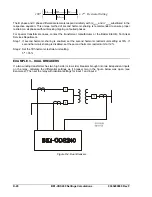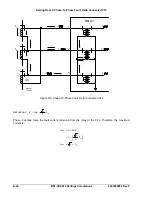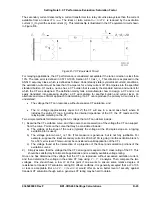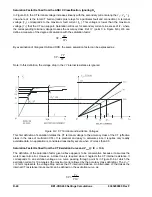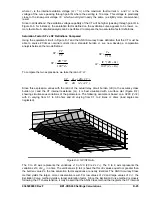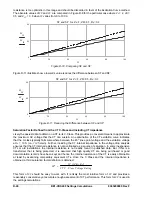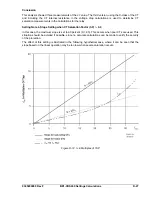
Table D-4. Parameter
Pa
r
tion
s for Equations to Calculate Ideal Taps
ramete
Description
Explana
MVA
MVA Base
Full load
MVA
or top rating of the protected equipment
KVn
each CT input circuit
KV Base for CT input
n
L-L Voltage in KV for
CTRn
r CT input
n
CT Ratio fo
Actual ratio not effective ratio
COMPn
Phase Compensation
Adjustment Factor for
CT input
n
3 if CT’s are connected in Delta (
ctcon
= DAB or DAC).
1 in all other cases.
See Section 3, Table 3-2 and Figure 3-3
NOTE
Please read the following notes found in the Example 1 calculations,
MVA Used in Tap
Calculations, CT Ratios
and
Tap Calculations,
3
Factor
.
S
Calculate ideal tap values. Use the top (e.g., FA) MVA rating of the transformer when making the
calculations. Since both CTs are wye connected, COMP1 and COMP2 are 1 per Table D-4. If the
actual power transformer rating
tep 2.
s at the no load tap position are used for the KV Base, the tap
adjust factor calculation can completely cancel this source of mismatch. However, if the no load
taps in the protected transformer could be changed without the BE1-CDS240 tap adjust factors
being reset, it would be safer to use the system nominal values and account for the additional
mismatch in the slope setting.
9365200990 Rev F
BE1-CDS240 Settings Calculations
D-15
79
.
2
60
*
69
*
3
1
*
1000
*
20
1
TAP
79
.
5
160
*
47
.
12
*
3
1
*
1000
*
20
2
TAP
are not in
tep 4.
Step 5 If tap ratio is less than 10 (and greater than 0.1) but one of the taps is beyond the range of 2 to
20, the taps may be adjusted as a whole linearly in a direction that maintains the original tap
ratios but brings all taps to within acceptable limits. For instance, if TAP2 had been calculated to
some value above 20, then reset TAP2 to 20 and reset TAP1 to a lower value using the equation:
Step 3. If the calculated TAP1 and TAP2 are in range, (2.00 - 20.0 for 5 ampere sensing input types or
0.40 - 4.00 for 1 ampere sensing input types) proceed to Calculate Minpu. If they
range, proceed with Step 4.
S
Calculate spread ratio. Determine the ratio of
TAP1
to
TAP2
. If greater than 10:1 (or conversely,
1:10), adjust the CT ratios to bring the tap ratios to less than 10 (or greater than 0.1).
2
TAP
20
Old
1
TAP
Old
1
TAP
New
Calculate Minpu
The minimum pickup restraint setting (minpu) adjusts the sensitivity of the relay. In non-numerical relays,
the minpu was fixed at a typical value of 0.35 of the relay tap. In the BE1-CDS240 relay, the user can
choose lower or higher values to optimize the protection in each particular application. Selecting a lower
minpu setting will tend to raise the slope setting to maintain a given margin at the knee-point of the
differential tripping characteristic. (For more information, see the
Calculate Slope
later in this section.)
Conversely, it is sometimes necessary to accommodate unmonitored loads in the differential zone. In that
case, the minpu setting may be higher. A setting of
0.25
per unit of
transformer full load (
FA
) rating
is
recommended for typical installations where no unmonitored load needs to be considered. This value is
well above the magnetizing current and provides a safe margin at the knee point of the slope
characte
in the
differen
ltiples
of tap.
ristic. If unmonitored loads such as station service or small capacitor banks are connected
tial zone, the minpu must be increased by the magnitude of the unmonitored current in mu
Summary of Contents for BE1-CDS240
Page 2: ......
Page 8: ...vi BE1 CDS240 Introduction 9365200990 Rev F This page intentionally left blank ...
Page 38: ...1 28 BE1 CDS240 General Information 9365200990 Rev F This page intentionally left blank ...
Page 40: ...ii BE1 CDS240 Quick Start 9365200990 Rev F This page intentionally left blank ...
Page 152: ...ii BE1 CDS240 Metering 9365200990 Rev F This page intentionally left blank ...
Page 226: ...iv BE1 CDS240 Application 9365200990 Rev F This page intentionally left blank ...
Page 286: ...ii BE1 CDS240 Security 9365200990 Rev F This page intentionally left blank ...
Page 290: ...9 4 BE1 CDS240 Security 9365200990 Rev F This page intentionally left blank ...
Page 292: ...ii BE1 CDS240 Human Machine Interface 9365200990 Rev F This page intentionally left blank ...
Page 306: ...10 14 BE1 CDS240 Human Machine Interface 9365200990 Rev F This page intentionally left blank ...
Page 308: ...ii BE1 CDS240 ASCII Command Interface 9365200990 Rev F This page intentionally left blank ...
Page 342: ...11 34 BE1 CDS240 ASCII Command Interface 9365200990 Rev F This page intentionally left blank ...
Page 349: ...Figure 12 5 Horizontal Rack Mount Front View 9365200990 Rev F BE1 CDS240 Installation 12 5 ...
Page 361: ...Figure 12 17 Typical DC Connection Diagrams 9365200990 Rev F BE1 CDS240 Installation 12 17 ...
Page 372: ...12 28 BE1 CDS240 Installation 9365200990 Rev F This page intentionally left blank ...
Page 468: ...13 92 BE1 CDS240 Testing and Maintenance 9365200990 Rev F This page intentionally left blank ...
Page 512: ...14 42 BE1 CDS240 BESTCOMS Software 9365200990 Rev F This page intentionally left blank ...
Page 544: ...ii BE1 CDS240 Terminal Communication 9365200990 Rev F This page intentionally left blank ...
Page 550: ...ii BE1 CDS240 Settings Calculations 9365200990 Rev F This page intentionally left blank ...
Page 578: ...D 28 BE1 CDS240 Settings Calculations 9365200990 Rev F This page intentionally left blank ...
Page 579: ......




















